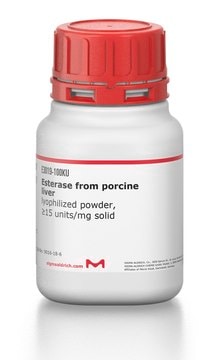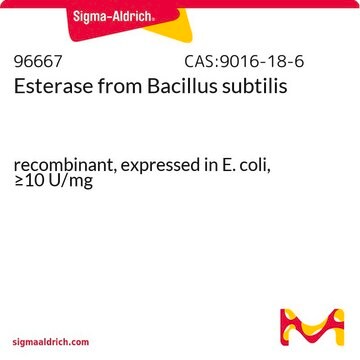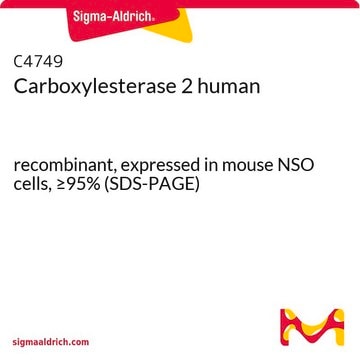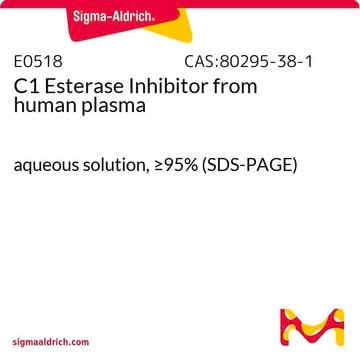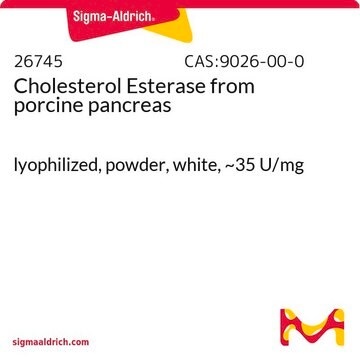E0887
Esterase from rabbit liver
lyophilized powder, ≥30 units/mg protein
Synonym(s):
Carboxyl esterase, Carboxylic-ester hydrolase
Sign Into View Organizational & Contract Pricing
All Photos(2)
About This Item
Recommended Products
form
lyophilized powder
specific activity
≥30 units/mg protein
mol wt
60 kDa
composition
Protein, ≥85% biuret
storage temp.
−20°C
Looking for similar products? Visit Product Comparison Guide
General description
Esterase belongs to the C-family of carboxylesterases. It is a glycoprotein, mainly present in the endoplasmic reticulum of hepatocytes.
Application
Esterase from rabbit liver has been used in a study to investigate a toxic effect of carbamate insecticides. Esterase from rabbit liver has also been used in a study to investigate the effect of simvastatin on expression and activity of a lipoprotein-associated phospholipase A(2).
Esterase from rabbit liver has been used:
- in comparative biophysical studies with bovine bile-salt-activated lipase in the assays with vinyl acetate, triacylglycerols, p-nitrophenyl esters and serine enzyme inhibitors
- in the catalysis and kinetic profiling studies of peptidic compounds
- in in vitro stability assays of prodrug compounds (BMS-292655 and BMS300043)
- in the hydrolysis of oleuropein aglycone (Ole-AG)
The enzyme from Sigma has been used to study the effect of divalent metal ions on the activity of esterase.
Biochem/physiol Actions
Esterase enzyme catalyzes hydrolysis of carboxylic ester to carboxylate and alcohol in the presence of water. Rabbit liver carboxylesterase catalyzes enantioselective hydrolysis of cineol derivatives.
Esterase enzyme has broad substrate specificity. Esterase from rabbit liver has been used to investigate the toxic effect of carbamate insecticides. Esterase from rabbit liver has also been used for the hydrolysis of simvastatin.
Unit Definition
One unit will hydrolyze 1.0 μmole of ethyl butyrate to butyric acid and ethanol per min at pH 8.0 at 25 °C.
Physical form
Lyophilized powder containing Tris buffer salts
Signal Word
Danger
Hazard Statements
Precautionary Statements
Hazard Classifications
Resp. Sens. 1
Storage Class Code
11 - Combustible Solids
WGK
WGK 1
Flash Point(F)
Not applicable
Flash Point(C)
Not applicable
Personal Protective Equipment
dust mask type N95 (US), Eyeshields, Gloves
Choose from one of the most recent versions:
Already Own This Product?
Find documentation for the products that you have recently purchased in the Document Library.
Customers Also Viewed
Ziwei Li et al.
Journal of pharmaceutical and biomedical analysis, 168, 13-22 (2019-02-19)
Simvastatin is known as a pro-drug, which could be hydrolyzed by esterases to its active form, simvastatin acid. Although pharmacokinetics of simvastatin and simvastatin acid have been widely studied, hydrolysis of simvastatin to simvastatin acid during blood sampling and plasma
Sisi Zhang et al.
Current protocols, 2(7), e489-e489 (2022-07-21)
Polysorbates (PSs), including PS20 and PS80, are non-ionic surfactants widely used in the pharmaceutical industry to enhance drug solubility and stability. Despite their wide application, PSs are prone to degradation by either hydrolysis or oxidation in drug formulations during storage;
Rami Akkad et al.
Journal of AOAC International, 95(5), 1371-1377 (2012-11-28)
HPTLC-enzyme inhibition assay was applied to different fruit and vegetable samples after individual spiking with organophosphate and carbamate pesticides at their maximum residue limits documented by the European Commission. Samples were extracted according to the QuEChERS (Quick, Easy, Cheap, Effective
J Ozols
The Journal of biological chemistry, 262(31), 15316-15321 (1987-11-05)
A glycoprotein having a subunit weight of approximately 60,000 was isolated from rabbit liver microsomes. It is a predominant component of the hepatic microsomal membrane and reacts rapidly with diisopropylphosphorofluoridate (DFP), resulting in the loss of enzymatic activity toward artificial
Z Qiao et al.
The Journal of international medical research, 37(4), 1029-1037 (2009-09-19)
Lipoprotein-associated phospholipase A(2) (Lp-PLA(2)) contributes to atherosclerotic plaque instability and subsequent sudden coronary death. Statins are associated with decreased stroke risk and may improve stability of atherosclerotic plaques. The present study investigated the effect of simvastatin on expression of Lp-PLA(2)
Protocols
Objective: To standardize a procedure for the enzymatic determination of Esterase activity using Ethyl Butyrate as a substrate.
Our team of scientists has experience in all areas of research including Life Science, Material Science, Chemical Synthesis, Chromatography, Analytical and many others.
Contact Technical Service